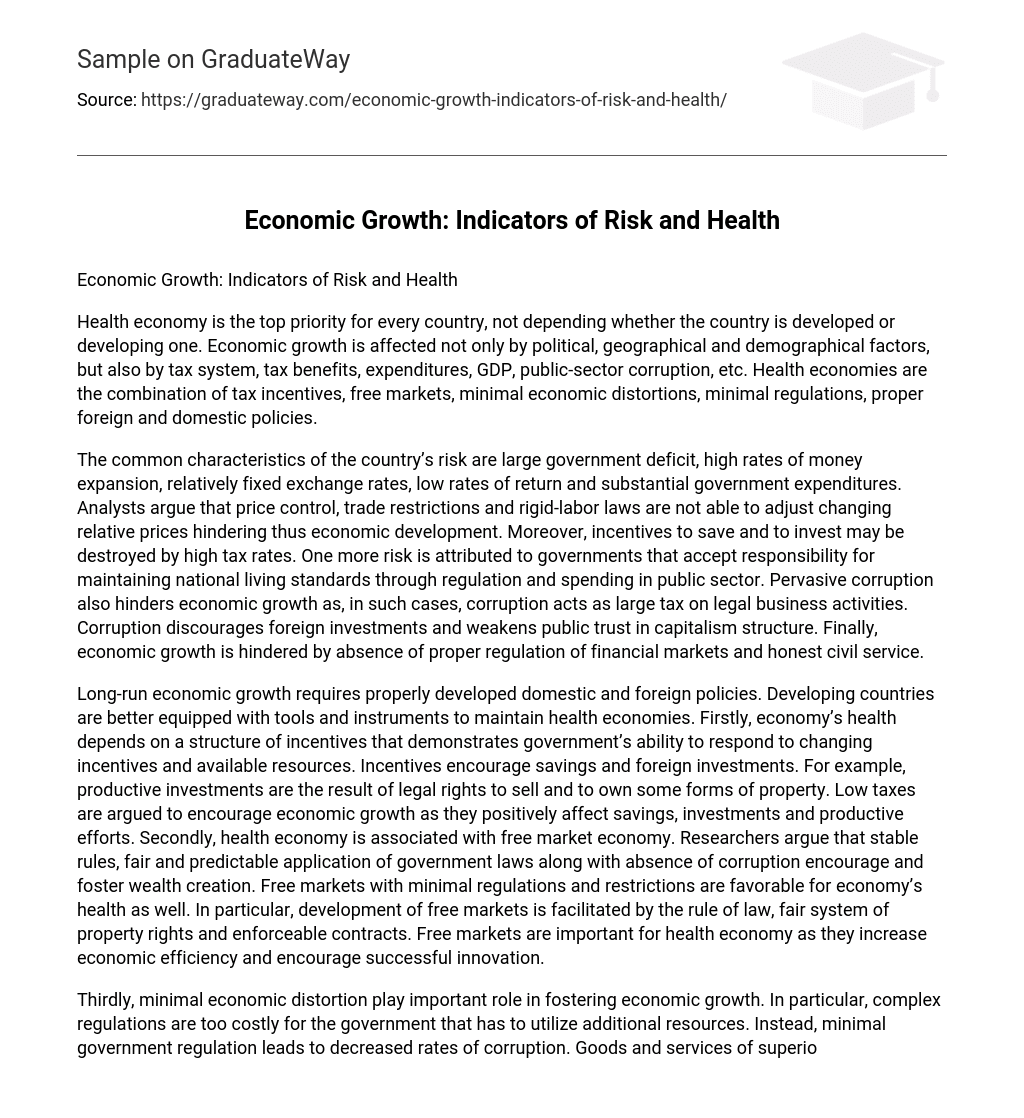Health economy is the top priority for every country, not depending whether the country is developed or developing one. Economic growth is affected not only by political, geographical and demographical factors, but also by tax system, tax benefits, expenditures, GDP, public-sector corruption, etc. Health economies are the combination of tax incentives, free markets, minimal economic distortions, minimal regulations, proper foreign and domestic policies.
The common characteristics of the country’s risk are large government deficit, high rates of money expansion, relatively fixed exchange rates, low rates of return and substantial government expenditures. Analysts argue that price control, trade restrictions and rigid-labor laws are not able to adjust changing relative prices hindering thus economic development. Moreover, incentives to save and to invest may be destroyed by high tax rates. One more risk is attributed to governments that accept responsibility for maintaining national living standards through regulation and spending in public sector. Pervasive corruption also hinders economic growth as, in such cases, corruption acts as large tax on legal business activities. Corruption discourages foreign investments and weakens public trust in capitalism structure. Finally, economic growth is hindered by absence of proper regulation of financial markets and honest civil service.
Long-run economic growth requires properly developed domestic and foreign policies. Developing countries are better equipped with tools and instruments to maintain health economies. Firstly, economy’s health depends on a structure of incentives that demonstrates government’s ability to respond to changing incentives and available resources. Incentives encourage savings and foreign investments. For example, productive investments are the result of legal rights to sell and to own some forms of property. Low taxes are argued to encourage economic growth as they positively affect savings, investments and productive efforts. Secondly, health economy is associated with free market economy. Researchers argue that stable rules, fair and predictable application of government laws along with absence of corruption encourage and foster wealth creation. Free markets with minimal regulations and restrictions are favorable for economy’s health as well. In particular, development of free markets is facilitated by the rule of law, fair system of property rights and enforceable contracts. Free markets are important for health economy as they increase economic efficiency and encourage successful innovation.
Thirdly, minimal economic distortion play important role in fostering economic growth. In particular, complex regulations are too costly for the government that has to utilize additional resources. Instead, minimal government regulation leads to decreased rates of corruption. Goods and services of superior quality are the most effective way to succeed in highly competitive environment. Fourthly, incentives to invest and to save maximize national chances of economic development. Finally, open economy and stable macroeconomic policies are important for increasing competition, providing comparative advantage, increases living standards and decrease poverty rates. Further, macroeconomic stability ensures is very likely to reduce economic risks, discussed above, to lower inflation rates, and to low real interest rates. Macroeconomic stability encourages people to invest in domestic policies and to stimulate further economic policies.
Summing up, the key indicators of economic risk are high taxes, absence of incentives, large government deficit and relatively fixed exchange rates. Corruption hinders economic growth as the public looses trust in capitalism system. Absence of free markets hinders economic development as well. In contrast, health economy is a combination of strong government incentives, low taxes, foreign and domestic investments, stable macroeconomic policies, free markets and minimal economic distortion. Open economy increases living standards and decreases poverty rates.





